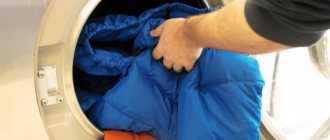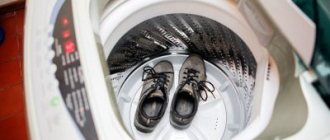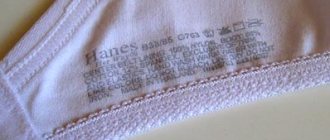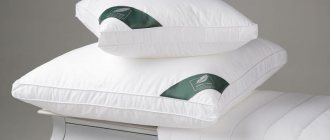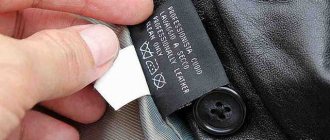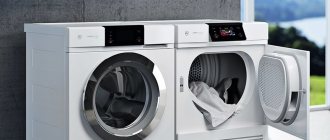Why is it so important to look at the instructions? First of all, you should look at the instructions; if your machine is very old, then it is possible that it has two inlet hoses for cold and hot water, respectively,
...and for some modes such machines took hot water, but still mixed it with cold water and heated it as needed.
Does the type of hot water supply affect washing and connection?
There are 2 types of connection to hot water:
- boiler room;
- boiler room
In both options, you can use hot water supply for the washing machine.
This is due to the fact that the device independently regulates the temperature of the supplied liquid, making it hotter as needed. For example, if a person sets the maximum temperature to 90 degrees.
Worth it or not
The manufacturer usually provides a connection exclusively to cold water. But there are models in which the possibility of double connection is realized - both to a cold pipe and to a hot one.
If you have an ordinary machine and you don’t know what water to connect it to, then know that it is better not to violate the manufacturer’s instructions. If the instructions indicate that the connection is only to cold, do so. Otherwise, the following consequences are possible:
- The heating element will burn out much faster despite the fact that logically it shouldn't be used and seems to have the potential to last longer.
- The quality of the wash will decrease . Some items, especially those made from delicate fabrics, can simply get damaged. If the water in your water pipe is supplied at a temperature of 60 degrees, even if you select a 30-degree washing mode, the item will fall into the water at the same temperature as the one in the pipe - the machine will not be able to reduce the water temperature.
- A lot of debris and dirt can get into the SMA body , since hot water is considered technical and does not undergo the same cleaning as cold water. In order for clean water to flow into the machine, you need a fine filter, and such a purchase will cost you a pretty penny.
- The water intake hose is often made of plastic or other materials that are not designed to handle high-temperature water, so be prepared to replace this part frequently.
There are also advantages to such a connection, which is why some advanced users choose it. You can save on electricity - that's a fact. But, given that the cost of hot water is not much lower than the price of energy resources, the benefit is very doubtful .
Pros and cons of such a decision
When connecting hot water supply to the machine, take into account the negative aspects that the user will receive:
- Inability to use high-quality delicate mode. The machine only increases the temperature, but does not decrease it. It is impossible to use temperature conditions below 50-60 degrees.
- Accumulation of debris in the housing. Tap hot water contains a large number of chemicals and is intended for technical use only.
- The need to purchase an additional filter, which will be expensive.
- Early damage to the inlet hose. It is made of plastic, which is quickly exposed to the negative effects of hot water and the substances it contains. It is intended for cold water use only. This device will gradually have to be replaced.
There are also positive aspects to using this method. Only high-quality and well-known manufacturers produce such equipment. The most popular brands do this. They provide a long warranty.
Some consumers note that using hot water reduces the risk of developing limescale. But there are many chemicals that prevent this effect. They can be bought at any hardware store.
The issue of saving electricity is quite controversial . On the one hand, energy consumption when heating the liquid is reduced. But a person will periodically need to replace parts that deteriorate during use.
Why does a washing machine need hot water?
If you connect hot water, you can pay less for electricity. However, the benefits are quite controversial. The price of hot water differs little from the cost of energy resources.
Scale often forms on the washer heater, which is difficult to get rid of. When connected to a DHW machine, there will be no limescale deposits. Meanwhile, there are many anti-scale products sold in stores. If you wish, you can remove plaque at home if you use one of the effective methods.
Consequences
What happens if you connect a washing machine to hot water? Negative consequences occur for equipment that uses plastic and metal parts.
Possible damage to linen without the possibility of restoring quality . This should be taken into account when considering connecting to a hot water supply.
For technology
Most washing machines are designed specifically for cold water supply. It goes through a multi-stage filtration stage, so the following are eliminated:
- grounds,
- acids,
- alkalis,
- chemical substances.
The water is safe for drinking in many regions of Russia, and therefore safe for washing. When it passes through the machine, a heating process occurs, which makes it possible to use different temperature conditions.
If you add hot water, the following parts become unusable:
- drain filter;
- inlet hose;
- pipes.
The contained chemical compounds settle on the surface of the devices. The equipment does not break down immediately, but gradually. Periodic replacement of devices will be required.
For laundry
When a person puts laundry into the machine, he chooses the temperature mode depending on its quality. For example, for cotton, 40 degrees with quick wash is suitable. For wool – delicate mode with cold water.
If you use a hot water supply directly connected to the machine, the following negative aspects will arise:
- The appearance of stains that cannot be removed even with the use of special stain removers.
- Lack of real characteristics of the selected mode, when hot water comes in instead of cold water (wool and cotton fabrics decrease in size).
It is recommended to wash fabrics that are suitable for high temperatures in a machine connected to hot water.
Progress
The washing machine can be connected to hot and cold water in different ways. It will be possible to install both main tees in front of the mixer without any problems; how to do this is described in our publication How to connect a washing machine to a mixer, so we will not dwell on this in more detail.
It will also be possible to install tees in front of the inlet hoses of faucets under the sink. This method is considered more aesthetic, since the connection point will be securely hidden under the sink. Let's do so.
Be sure to seal all connections with FUM tape to reduce the risk of leakage.
Although your washing machine works well, taking in both cold and hot water, you still need to make sure that less dirt gets into the system from the water supply, so first we’ll screw flow filters onto the taps. Next, we will perform the following manipulations.
- We shut off the risers with hot and cold water.
- We climb under the sink and find the junction of the metal-plastic pipe with the hoses going to the sink faucet. We disconnect the hoses and pipes.
- Next, you can screw our tees onto both pipes through adapters, which are already assembled with flow filters.
- We screw the hoses from the mixer to the tees.
- We screw the inlet hoses from the washing machine to the tees. Here you need a FUMka, you can’t go anywhere without it, because all connections must be sealed.
Now you can turn on the water and check how the washing machine connected in this way will work. During the inspection, pay special attention to the tees and hoses, make sure that nothing is dripping anywhere.
In conclusion, we note that connecting a washing machine to either cold or hot water is not a difficult task. Perhaps there is no difference here. But does your “home assistant” need this? Most likely, it is not necessary, unless, of course, your washing machine from the factory has a dual connection function for hot and cold water!
Interesting:
- How to choose a brand of washing machine?
- Comparison of technical characteristics of washing machines
- How to connect a dishwasher to water supply and sewerage
- How to choose a washing machine according to its parameters?
- How to connect a dishwasher to hot water
- Russian-made washing machines
readers
- 11/15/2017 at 14:56
Ivan:
Is it necessary to connect hot water if I have two inputs?
Answer
- 02/14/2018 at 14:45
Alexander:
You can install a water splitter so that there is pressure at the hot inlet. If the machine is connected to cold water supply and hot water supply, then such a splitter is included in the delivery package of the washing machine.
Answer
- 01/26/2018 at 09:04
Vladimir:
My Indesit was connected only to hot water. The machine worked for 16 years. Today I am changing the washing machine. And I'll connect it the same way again. I only have this pipe free.
Answer
- 05/18/2019 at 12:26
Vyacheslav:
The most reliable option is to install a three-way thermostat (mixer). They usually have outlet temperature control and different temperature ranges. I have a range of 32 - 50 degrees and both the washing machine and the dishwasher are connected. Fortunately, it has its own heating system (gas boiler + boiler) and a well. That is, there are filters and adequate pressure. But in central heating and water supply systems, you need to take care of water purification and install check valves for cold and hot water, because The pressure may be different and it will not work correctly.
Answer
- 10/13/2020 at 00:29
Michael:
Old machines can be connected, but new ones have many automatic washing modes. There may be glitches. Yes, and the washing machines are not the same now. Savings on everything. The plastic may warp, if you supply it with warm water from the boiler - 40 degrees. Washing will happen quickly due to the fact that there is no need to heat the water.
Answer
- 07/07/2018 at 15:22
Nastya:
I have a semi-automatic. We connected hot and cold, but only cold washes. The hot water doesn't flow. Why?
Answer
- 12/28/2019 at 19:04
Vladimir:
Open the tap
Answer
Types of connected washing machines
Washing machines that can be connected to hot water supply are produced by the most common brands that produce high-quality models.
These include:
- Bosch,
- Samsung
- LG,
- Philips,
- Indesit,
- Electrolux,
- Ariston,
- Vitek,
- Beko.
It is recommended to verify connectivity before purchasing. Consult the store that sells the device about this. It is better to read more about these properties in the instructions; it directly states how the installation takes place.
Connection
It is produced the same way in any version - hot or cold. The process is described in detail in the instructions. Use the inlet hose included in the kit. If necessary, purchase a longer one separately.
What you need to connect:
- gas and adjustable wrenches;
- fluoroplastic tape FUM;
- equipment for soldering polypropylene pipes;
- fittings for plastic and metal-plastic.
Step-by-step instruction
If the plumber or the consumer himself makes the connection, he must know what tools will be needed.
Actions occur according to a certain algorithm. They are followed strictly to eliminate the possibility of sudden breakdown.
Tools, materials
To connect you will need the following equipment:
- adjustable wrench;
- tape made of sealing material;
- ¾ gasket rings made of rubber or silicone;
- three-way valve ¾ (having three inlet holes);
- flow-through water filter;
- adapter for connecting the device.
Be careful when using a chrome tee or faucet. It is not strong enough, so it can be damaged by a plumber's wrench. To eliminate the risk, electrical tape is applied to the areas where it is attached.
Algorithm of actions
Before installation, it is important to eliminate the risk of contamination from debris that spreads from the water supply. To do this, screw the filters onto the tees.
Only then follow the following step-by-step instructions:
- The water supply riser is closed.
- Under the sink they find a pipe made of metal or plastic. Hoses extend from it to the mixer. These devices are disconnected.
- A tee is screwed onto each pipe using an adapter.
- First the mixing hose and then the intake hose are connected to the screwed tees in turn. A tape of sealing material is placed on top to make the structure airtight.
- Install a water supply system into the washing machine. Restart the riser to check the correctness of the actions performed.
If the entire algorithm is performed correctly, there will be no leaks in any part of the installed system.
Everything you need to know about hot water is presented in this section of the site.
Calculation of electricity consumption during washing
In order to calculate electricity consumption, you first need to find out how long it takes to heat the water. I dug around on the Internet and found in one section “Calculations for the home” that: “in everyday life you can use an adapted empirical formula, according to which the time t (in hours) required to completely heat the water in the tank of a storage water heater (and a washing machine is also a kind of tank), is defined as follows":
,where V is the volume of the tank (l), for our case it will be 15.5 liters; T2 is the temperature of the heated water (let’s take approximately the average 60°C); T1 is the initial temperature of cold water, in a water supply it is usually about 8°C; W is the electrical power of the heating element (kW), Bosch says: 2.2-2.4 (kW), let’s take the average 2.3. Let's substitute:
For your information, 0.41 hours is almost 25 minutes. In order to calculate the energy consumed during this time, you need to multiply the electric power by the time received:
If we take into account that during heating the drum motor also works (it rotates from time to time), then the resulting figure can be rounded to 1 kW*hour.
Types of washing units
Today, automatic machines are mostly used for washing. Manual and semi-automatic models are no longer so common in our homes. Automatic machines perform a full washing cycle, from soaking to rinsing and drying.
Connecting the washing machine to the water supply
Important! Ultrasonic devices are also produced that clean contaminants using generated ultrasound.
An interesting modification of automatic machines are bubble models. They perfectly remove stubborn stains with minimal impact on the material. However, the cost of such equipment does not yet allow everyone to purchase it.
Air bubble washing machines
Loading into the washing machine can be done either frontally or vertically. In the first case, the door is located on the front panel; such equipment can be built into kitchen units. The upper surface of the unit can be used to place items needed in the household. However, to load laundry and remove it, you have to bend over, which is not always convenient.
Front loading model
In vertical models, the hatch is located on top. Thanks to the tank being mounted on two axes, there is less vibration during washing. During the cycle, additional loading can be done. But the price of such machines exceeds the cost of frontal analogues. Moreover, they cannot be embedded.
Top loading model
Table. Comparison of vertical and frontal type machines.
| Possibilities | Vertical unit | Front car |
| Model selection | — | + |
| Price | — | + |
| Convenience for the consumer | + | — |
| Possibility of integration into kitchen modules | — | + |
| Compactness | Small machine width | The equipment is wider, but compact models can also be selected |
The operation of both types of equipment is almost the same.
Prices for popular models of washing machines
Washing machines
How do you know if your washing machine is heating the water during washing?
If the washing machine does not heat the water during the washing process, then many components of the washing powder will not be used 100%. As a result of such operation of the household appliance, it will not be possible to wash the laundry efficiently. This article will talk about how you can check whether the washing machine is heating the water, as well as the main causes of the malfunction.
Cold wash gel and powder
Detergents for cleaning clothes in cold water have special requirements:
- They must combine both traditional detergent enzymes and specific surfactants that can remove dirt under the most unfavorable conditions.
- Powders must be completely dissolved in cool water, otherwise a hard coating will be deposited on the drain pipes, preventing the normal discharge of waste liquid.
We recommend: How to wash holofiber pillows using a washing machine and not spoil the products?
We list the detergents that are suitable for “Cold Wash”.
Spark
The product contains natural optical brighteners and enhanced enzymes that penetrate deep into the fibers and remove old stains and other contaminants. Suitable for cleaning white and colored laundry, excluding wool and silk.
Pros and cons of Spark powder
compound
no odor
efficiency
without phosphates
not suitable for wool and silk
Part Search
If you have doubts about the performance of the heating element, you will have to “ring” it with a multimeter. First you need to find the device itself in the machine. Its location largely depends on the manufacturer’s brand, for example, in Indesit and Ariston it is located at the back, in models from Bosch and Siemens it is at the front.
Having in hand the factory wiring diagram for the heating element in the washing machine, you can speed up the search.
If there are no instructions, then we look for the heater ourselves:
- We examine the back wall of the machine. Often a large panel indicates a heating element located behind it;
- put the body on its side or tilt it back to look into the bottom and try to detect the heating element near the washing tub;
- remove the back cover and carefully inspect the space around the tank;
- We take a flashlight, shine a light through the inside of the drum and try to determine by eye the location of the heater.
The task is simplified by the fact that the heating element is always in the washing tub. It is only necessary to specify its location. There is no need to remove the device - you can “ring” the heater without removing it. We’ll tell you how exactly later.

